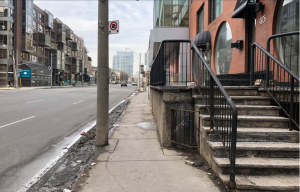There is no reason to fear a safer Avenue Road
Toronto Star, February 18, 2024
There was a time when city hall routinely rejected community demands for changes to arterial roads — even when motivated by safety concerns — by pointing to a road’s designated function to move lots of cars, fast.
Making Avenue Road more bike and pedestrian friendly should serve as another success story for a city ready to address urgent problems of road safety and climate change.Fortunately, the times, and city priorities, have changed. High-speed, six-lane Avenue Road, between Bloor Street West and St. Clair Avenue West, is the latest road on the verge of a makeover with interim measures to convert it to a calmer, safer four lanes, in advance of full reconstruction at a later date. With public consultations now complete, and a committee vote on the final staff recommendations scheduled for March, city hall may now be ready to deliver.
 It’s no surprise that most people, even avid drivers, prefer to live on a residential side-street, given the danger, noise and tailpipe exhaust of cars and trucks on arterials. But in a growing city with high housing prices and restrictive zoning rules, the reality is that people will live where they can.
It’s no surprise that most people, even avid drivers, prefer to live on a residential side-street, given the danger, noise and tailpipe exhaust of cars and trucks on arterials. But in a growing city with high housing prices and restrictive zoning rules, the reality is that people will live where they can.
In fact, even though Avenue Road is designated as an arterial, more people (including residents of seniors’ homes, apartments above shops, and in the burgeoning number of residential towers) live along this 2.1-kilometre segment than on any local side-street.
Changes to road design should now come easily in our city, given Toronto’s Vision Zero Road Safety Plan and Complete Streets Guidelines, and the frightening advance of climate change.
And yet it has taken seven years for our coalition of parent, school, social justice, and residents’ groups to convince City Hall to act on two simple asks: lower motor speeds and wider sidewalks. Thankfully, city staff have put forward a new design that includes broader pedestrian spaces, a vital bike lane connection between Bloor and Davenport Road, and lower speeds.
There is opposition to the change. It’s coming, as usual, from motorists, who complain about longer driving times, even though city modelling shows estimated rush hour delays of only 60 seconds.
Other opponents worry about the potential neighbourhood infiltration of cars, though not speeding at upwards of 70 km/h, as on Avenue Road. The success of city policies, however, depends on reducing motor traffic, not simply redistributing it. City staff, in any case, have a suite of available measures to address any actual problem.
Ironically, some opponents live in the beautiful, adjacent South Hill neighbourhood that once benefited from a similar initiative. Until 1979, Poplar Plains Road, then cynically derided as the “Forest Hill Expressway” between Dupont Street and St. Clair Avenue, allowed northbound motorists to race, two cars abreast, up one-way Poplar Plains to St. Clair, where a police officer guided them, first right then left into Forest Hill.
The introduction of a 550-metre-long bike lane narrowed the speedway to a single car lane. The bike lane (the first and only one in Toronto until a decade later) faced shrill opposition, including from a then more pro-car Toronto Star, which labelled the initiative “Another Devastating Attack of the Anti-car Blues.” The bike lane would likely not have survived but for its traffic calming benefits for local residents.
Albert Koehl is a founding member of the Avenue Road Safety Coalition and author of forthcoming Wheeling Through Toronto (May 2024).